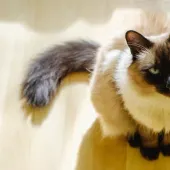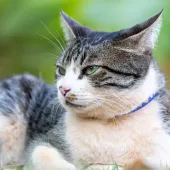The Enigmatic Charm of American Bobtail Cats: Nature's Playful Masterpiece
In the vast tapestry of feline diversity, the American Bobtail cat breed emerges as a fascinating and endearing marvel. With its distinctive bobbed tail, wild appearance, and affectionate nature, the American Bobtail has etched its place in the hearts of cat enthusiasts worldwide. Let's embark on a journey to uncover the unique allure of this captivating feline companion.
A Tail Unlike Any Other:
The most striking feature of the American Bobtail cat is undoubtedly its tail. Unlike most cats, the American Bobtail's tail is naturally short, resembling that of a wild bobcat. This characteristic, resulting from a genetic mutation, gives them an enigmatic charm that sets them apart from other breeds. Each tail is unique, varying in length, shape, and flexibility, adding to their individuality.
Wild Appearance, Gentle Heart:
While their appearance might evoke a sense of the wild, American Bobtails are known for their gentle and affectionate temperament. These cats are highly social, forming strong bonds with their human families. They are intelligent, curious, and playful, making them delightful companions for households with children and other pets. Their friendly disposition and adaptability make them an excellent choice for families seeking a loving and interactive feline friend.
A Rich Tapestry of Coats:
American Bobtails come in a variety of coat lengths and patterns, ranging from short to semi-longhaired. Their coat is dense and plush, providing a soft and luxurious texture. The breed showcases a wide array of colors and patterns, allowing for a diverse and visually appealing range of appearances. Whether adorned in solid colors, tabby patterns, or spotted coats, each American Bobtail cat is a unique work of art.
Playful and Intelligent Companions:
American Bobtails are renowned for their playful and intelligent nature. They are curious explorers, always eager to investigate their surroundings and engage in interactive play. Puzzle toys, feather wands, and climbing trees are just a few ways to keep their active minds stimulated. Due to their intelligence, they can be trained to perform tricks and enjoy interactive games with their human companions, fostering a strong bond between pet and owner.
Guardians of Ancient Folklore:
Beyond their contemporary charm, American Bobtail cats hold a special place in folklore and mythology. Native American legends speak of cats with shortened tails, revered for their mystical qualities and believed to bring good luck to those who encountered them. This mystical aura adds to the allure of the American Bobtail, making them not only beloved pets but also guardians of ancient wisdom and tales.
In conclusion, the American Bobtail cat breed stands as a testament to the wonders of nature, combining a distinctive appearance with a warm and loving temperament. Whether admired for their unique tails, playful antics, or affectionate companionship, American Bobtails continue to enchant cat lovers, reminding us of the extraordinary beauty and diversity found in the feline world. Embracing the wild with a gentle heart, the American Bobtail cat remains a masterpiece of nature, bringing joy and comfort to homes around the world.
Background and History
The American Bobtail breed is not new to America; it was brought here in the 1960s, but it has just gained popularity. And while the exact origins of this breed are unknown, it is generally accepted that a seal point Siamese female and a short-tailed brown tabby male named Yodie mated to create the breed.
While on vacation close to an Indian reservation in Arizona, John and Blenda Sanders of Iowa came into possession of Yodie. Yodie's parents are unknown, though he had a short tail. He then added Birman, Himalayan, and a Himalayan/Siamese hybrid to the lineage.
The initial standard for this cat was authored in the 1970s by Mindy Schultz, a friend of the Sanders and breeder of Bobtails. However, this breed did not advance very far because of a shortage of resources. Sadly, the majority of these ancient bloodlines have since disappeared. Later, in the 1980s, a few breeders made the decision to create a Bobtail that was a tad more flexible. They started a new breeding program, departing from the original blueprint, which was essentially a longhair with a short tail that was pointed and had white mittens and a white facial blaze.
Thanks to the efforts of these breeders, a new Bobtail has evolved that is available in every hue, division, and category. The breeder in Florida who mixed domestic cats with bobcats is the source of its seeds. The veracity of this tale is still in question, though, as numerous specialists have stated that a pairing like this would result in infertile kittens. The idea that this short-tailed cat originated from a naturally occurring mutation among domestic cats is a more plausible explanation.
Although the breed is still in its infancy, it has achieved great success in its area.
Care and health
Bobtail cats are less prone to serious medical issues than cats from smaller gene pools because of the "natural selection" breeding techniques utilized in their breeding. Even though tailless Bobtails are able to lead healthy lives, it is nevertheless advisable for them to see a doctor at least twice a year to prevent spinal diseases or incontinence issues.
Like the Manx, another tailless breed, American bobtails without tails may experience intestinal or spinal problems.
The American bobtail is prone to develop hip dysplasia with age, a hereditary disease that has the potential to cause lameness and arthritis of the hip joints." Furthermore, it has been documented that tailless American bobtails can develop a spinal disease that could impair their control over defecation. (Kurt Venator, DVM, PhD)
Oolder American bobtails are susceptible to hyperthyroidism and kidney disease, which are common disorders of older cats.
Interesting facts
- American Bobtails are great companions when traveling. It's not well recognized that cats are good travelers, and the majority of breeds find it difficult to settle down or stop crying during lengthy car rides. An exception to this is the American Bobtail, a beloved companion of long-distance truck drivers. Bobtail cats are peaceful and quiet during lengthy drives, in contrast to other breeds who hate it. Some cats even drift off to sleep.
- A dominant gene is in charge of the bobbed tails.
The American Bobtail has a dominant gene for bobbed tails, in contrast to the recessive gene seen in Japanese Bobtails. While the majority of Bobtails have short tails, some are tailless at birth. Because tailless cats are more likely to experience problems with their spinal cords, breeders typically do not breed them in order to safeguard the health of subsequent generations. Still, some tailless cats have long, robust lives free from serious health issues. - American Bobtails have dispositions akin to those of dogs.
American Bobtails have been likened to dogs due to their devoted nature to their human families, as well as their enjoyment of sports and walks on a leash. Some cat enthusiasts even call them the “Golden Retriever of cats.” Leash training is a great option for Bobtails, and the majority of Bobtail owners think their pets love their daily strolls around the neighborhood. - All cats like to play games with people, but Bobtails are more like dogs in that they will willingly track down toys and give them back to their owners. They don't hesitate to retrieve objects that you toss to them and frequently carry their toys about the home in their jaws.
- Tail wagging is another trait the breed has in common with dogs. Bobtails wag their tails while they are playing and when they are in need of attention. Bobtails occasionally stand close to their leash or harness until their owners take them for walks outdoors, just like the majority of housebroken dogs.
- Nothing at all happens to an American bobtail during birth. We call those kitties "rumpies."
Occasionally, the canine-like American bobtails will wag their tails to show joy.





